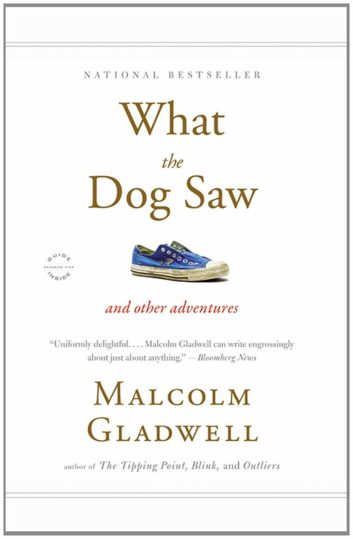
It is always my intention to read interesting books. It has been my experience that interesting books tend to be penned by interesting authors. Malcolm Gladwell effortlessly falls into this category.
Gladwell’s mother was a Jamaican psychotherapist and his father a British professor of mathematics. I can only imagine the dinner conversations in that house. He admits he did not have the grades to go to grad school, so he decided on a career in advertising. After being rejected by every ad agency to which he applied, he took a position as a journalist. I humbly submit the world is a better place for that decision.
He cut his teeth at the American Spectator but really hit his stride when he joined the New Yorker. Gladwell enjoys looking at people and topics from unique angles and has a way of making even the most mundane thought process or activity absolutely fascinating. Before you read further, I will warn you that once you have begun one of his books you will most likely want to consume his entire catalog. With bestsellers like The Tipping Point, Blink, and Outliers, Gladwell established an impressive reputation for insight and detail while pushing his readers to reexamine established thinking on a variety of subjects.
For this month’s column I have chosen his fourth book, What the Dog Saw: And Other Adventures. This is a collection of his favorite articles from The New Yorker since he joined the magazine as a staff writer in 1996.
Also in the Business Book Club: The Leadership Secrets of Attila the Hun by Wess Roberts, Ph.D.
As an anthology, the book covers a myriad of topics seemingly unrelated other than by the exceptional perception of the author. It weaves a series of discreet stories and anecdotes into a cohesive account of unbridled wonder at the lives and accomplishments of people from all walks of life. He breaks the collection down into three sections:
- Obsessives, Pioneers, and Other Varieties of Minor Genius
- Theories, Predictions, and Diagnoses
- Personality, Character, and Intelligence
Here’s a taste:
From section one, Gladwell begins with “The Pitchman” and Ron Popeil, the master of the infomercial, whose gadgets range from the Pocket Fisherman to the Showtime Rotisserie. While many remember him only as a carnival barker, his story from beginning at his father’s knee on the Atlantic City Boardwalk to his “conquest of the American kitchen” is incredible. Business acumen and intense attention to detail are exemplified as Popeil is not only interested in creating a massive sales machine, but in truly delivering the absolute finest product in the category. So many business lessons in less than 30 pages.
From section two comes “The Art of Failure, Why Some People Choke and Others Panic.” This treatise on the difference between explicit and implicit action is revelatory. It features critical life lessons, beginning with an example of the 1993 Wimbledon final between Jana Novatna and Steffi Graff. Next, the crash into the Atlantic that took the lives of John F. Kennedy Jr. and his passengers. Last, Greg Norman’s spectacular collapse in the final round of the 1996 Masters Championship.
All of these events show the effects of pressure on performance — the frustration of overthinking the solution or reverting to fundamental mechanics when what is needed is a clear mind and practiced confidence. Every example teaches a valuable lesson that could dramatically affect the outcome of a major future experience in your life.
In section three there are several I could cite, but the one that triggered me was “The Talent Myth, Are Smart People Overated?” This topic begins and ends with Enron and its primary consultant, McKinsey and Company.
Also in the Business Book Club: The Greatest Salesman in the World by Og Mandino
The overwhelming addiction to hiring the best and brightest resulted in a dangerous dependence on individual “stars” who were allowed to virtually name their price and make decisions far beyond their abilities. Stars were overcompensated and rewarded even when they failed at a particular venture. The willingness to take risk outweighed the value of solid business practices and personal accountability.
An example is given of Lou Pai, who began Enron’s power trading business and lost tens of millions of dollars by attempting to take advantage of the residential power segment in newly deregulated markets. He then was given the chance to build the commercial electricity outsourcing business where he ran up several more years of heavy losses before cashing out with $270 million. Talented stars were rewarded for failure even if that failure ended up on the cover of the Wall Street Journal.
The fall of Enron has been documented in several books and articles. However, Gladwell’s assertion that at the core of its demise was a narcissistic culture that rewarded talent over competency is quite compelling.
As in other reviews, I must point out that any section or article in this volume stands on its own. You may be tempted to peruse the table of contents and only read those that seem applicable to your particular situation. However, some of those that, at first glimpse, seemed outside my particular purveyance were my favorites. I mean, how can you go wrong with a title like, “The Ketchup Conundrum.” Mustard now comes in a dozen varieties — why has ketchup stayed the same?
Trust me, it just gets better.







